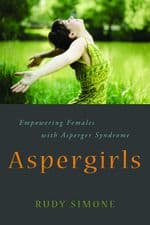9 Ways Girls with ASD differ to Boys with ASD
- Their special interests are usually animals, music, art, literature.
- They often have a very good imagination which includes imaginary friends, games, being animals or taking on persona of other girls.
- They often see speech therapists for their speech and may be diagnosed with specific language disorders, however, there is something different about this girl no one can quite put their finger on.
- They often play with older children or children that are much younger. This play is sometimes unusual for example ‘Mums and Dads’ but she will want to play the same role and game every time. She usually wants to be the pet or baby,whereasmostgirlswanttobetheMumorDad.
- They often have hyperlexia – meaning they have the ability to read but their comprehension skills do not always match their reading skills. They are often the class book worm or write stories but they write the same story over and over again changing a few characters. Many have a special interest in literature.
- Like the boys they get anxious, however, their anxiety is rarely physical or disruptive. In fact many have great coping mechanisms at school however the family see a very different child at home where the anxiety can explode.
- Often their difficulties with social skills are called ‘shy’, ‘quiet’, ‘solitary’.
- They often like to organise and arrange objects. I watched one little girl spend hours appearing playing ‘My Little Ponies’ however on closer examination she was just arranging and re-arranging the horses over and over.
- The main difference is there are significantly more undiagnosed girls/women than boys/men. Currently, only ? girl is diagnosed to every 7 boys. In the future it is thought by many psychologists the ratio could be more like 5 to 7 as we become more aware of this group.If you want to understand more about girls with ASD I HIGHLY RECOMMEND you ‘like’ Yellow Ladybugs on Facebook
Recommendation for Girls
There are some wonderful books to explain how ASD presents itself differently in girls; how they can be diagnosed, how they can be be helped and how they can help themselves. The two books below are both wonderful read and I would encourage anyone who knows a girl with ASD to consider reading these books. Many girls and women I know with ASD love reading so by providing information to them in books it can empower them and help them to understand they are not alone.
One of my favourite books is Aspergirls by Rudy Simone. Here are my favourite excerpts, which give amazing insights and information.
“Aspergirls do not thrive under scrutiny, if it has just the slightest bit of hostility in it. Whether from our peers or teachers, if we are looked at with an unfriendly, intimidating, or threatening eye, we fold. Alone we are talented, graceful, witty, and smart, but under such circumstances we curl up like hedgehogs.” -I know many girls who do this one!
“I always felt different from my family; they seemed unpredictable and frightening. I was known to be gifted intellectually but I was so profoundly affected by AS that as puberty kicked in, I went through bouts of mutism which could last hours or even a whole day.” – Rudy Simone oscillated from performing for attention to shutting down completely – a swing of moods which she says is typical for ”Aspergirls”.
My other favourite book relating to girls with ASD is Danuta Bulhak-Paterso’s fabulous picture book called I am an Aspie Girl. She wrote this book so girls could have a resource they could relate to.Danuta feels it is important not only to have a thorough understanding of ASD but also to adopt a positive attitude about the condition. She believes a genuine appreciation of the wonderful gifts that come with a different way of thinking will help the girls value themselves. The book aims to help girls understand themselves to discover their unique way of thinking and strengths. I love the way the book asks great questions:
- “Do you find playing in a group tricky?”
- “Do you sometimes find it hard to understand howyou are feeling?”
- “Do you worry about making mistakes?”Watch the FREE Dr. Tony Attwood webinar available for limited periods, where he discusses the profile and characteristics of girls with ASD.
More information at elearning.suelarkey.com.au
Fantastic Books for Understanding Girls
Aspergirls: By Rudy Simone
This book will be essential reading for females of any age diagnosed with ASD, and those who think they might be on the spectrum. It will also be of interest to partners and loved ones of Aspergirls, and anybody interested either professionally or academically in Asperger’s Syndrome.
I am an Aspie Girl: By Danuta Bulhak-Paterson, Foreword by Tony Attwood
Lizzie is an Aspie Girl – she has Asperger Syndrome, which means that her brain works differently to her friends and even to boys with Asperger Syndrome. In this book, Lizzie explains what it is like to be an Aspie Girl, including how she has a special talent for blending in with her friends, how she gets really tired after being at school all day, how she worries about making mistakes, and how she finds it hard to understand how she is feeling




 Sorry we no longer ship items outside Australia. Please consider the digital versions of Sue’s Books –
Sorry we no longer ship items outside Australia. Please consider the digital versions of Sue’s Books – 